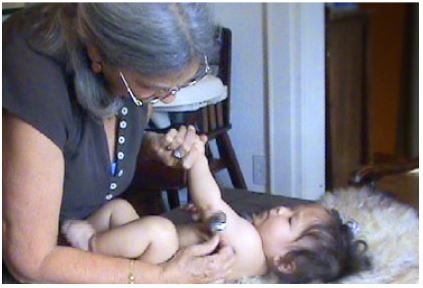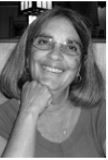Pediatric Acupuncture
SHONISHIN
Shonishin is a pediatric method of acupressure, massage, and needling that was developed in Japan and based upon TCM theories that are 2000 years old. It first came into practice in the 17th century, but in the last 75 years has become the main treatment for children throughout Japan. The word Shonishin translates exactly as pediatric acupuncture. Shoni is pediatric, and shin is acupuncture.

Shonishin in Japan is normally performed on children during the week of the full moon. If the day of the full moon falls on a day when the clinic is not open, the treatment is done prior to the full moon rather than after. Many of the Osaka clinics are open only to children for that particular day during each month, so adults needing treatment might have to go elsewhere. Shonishin clinics are typically named after some animal, and on that special day of full moon Shonishin, a flag with an image of that animal is flown outside the clinic, to alert the parents that “this is the day for children”.
When a child is given 12 treatments per year at one per month, problems that might arise due to weather, diet, emotions, or lifestyle will be clearly seen by the practitioner and the child’s treatment can be fine-tuned for those types of concerns. Also, with regular monthly healthcare, both parents and children begin to see that the rhythm of caring for self is an ongoing process that continues throughout life. This is quite different from the treatment model of allopathic care, which favors either prevention via immunizations or treatment for problems once sickness has already occurred. Shonishin, like all of Traditional Chinese Medicine, emphasizes wellness and the care it takes to maintain that state. Unfortunately, only a handful of North American parents know to bring their children in for the monthly rhythm of Shonishin. Historically, most of my pediatric clients have been brought for treatment because their parents desire to break away from cyclical pharmaceutical treatments and the possible side effects of their use. Once introduced to Shonishin, some parents realize the brilliance of ongoing wellness-care for their children and dutifully show up approximately once a month for treatment.
On many of the days that my clinic had full moon Shonishin, between fifteen and twenty children would be scheduled. This would be a day of toys, balloons, songs, and a good deal of kid noise. For new patients whose parents were unsure of this work, they would frequently be invited into the treatment room of another child so that they could see what was being done. As such, there was always a type of community education that went on, unlike private practice acupuncture. This formed the possibility of networking between parents and children that often formed lasting friendships. When a baby or child is not well or there is an ongoing health condition, treatments should be given with greater frequency until the appropriate adjustments and changes are made and the ongoing problem is corrected. My experience is that for the vast majority of children with chronic problems, one weekly treatment is what most require, and usually not more. When treatments occur with this frequency, the practitioner is following through with a treatment protocol that was previously prescribed, and as a result, the intake is hopefully brief. Because of this, the child can be in and out of the office within ten to fifteen minutes, which is about what most children can handle time-wise. Dr. Mori said that Shonishin treatments should not last more than ten minutes for the child, and with the intake and advice, the total time spent in the treatment room should be close to a fifteen minute experience, or less, if possible. When there is a good deal of education that must be given to the parents, they (or one of them) can schedule a consult with the practitioner to spend time needed for the type of education that allows them to become part of their child’s ongoing care. If this is necessary, it should be done without the child present, so that the child will not become bored or demanding. In this way the parent can be fully present to learn the techniques that will allow them to become the main player in their child’s healthcare.
Pediatric acupuncture begins at birth if necessary, and is used for children typically from birth to six, seven, or eight years old, depending on the child. By this time, a child who has received Shonishin throughout his or her life has likely been introduced to needles enough that they will happily receive a needle treatment, where needles are retained for approximately five to ten minutes. I mention birth as the beginning of Shonishin treatment. This is for children who have been diagnosed with some type of problem. Typical neonatal problems could be jaundice, brachial plexus, failure to thrive, or some kind of brain damage such as cerebral palsy. Otherwise, babies and children typically begin Shonishin when their parents are ready to bring their child in to a practitioner for a wellness evaluation or for a consult. Common pediatric conditions seen are: colic, night crying, digestive problems, common cold, fevers, ear infections, coughs, pertussis, asthma, allergies, bed wetting, skin conditions, problems in behavior, sleeping, and hyperactivity.
Typically Shonishin treatments are done by using little tools to rub, scrape, or tap along certain points and certain meridians. Almost 100% of children love this attention and stimulus, so practitioners should not fear working on a child of any age, as they most often respond well to treatment. The tools used for Shonishin can be purchased through oriental medical supply sources, and as a practitioner uses them, she/he will also find tools from nature that can also be used for similar or identical techniques. Shells of all sizes and shapes make excellent tools, as do buttons and other household objects.
Shonishin is a powerful tool for the maintenance of wellness, prevention of disease, and the treatment of disharmony, illness, or pathology. Treatments will stimulate the immune system by stimulating endorphin production in the body, which in turn stimulates healing. It also addresses the spirit and gives a feeling of general well-being to the child. Frequently, practitioners will be delighted to see how excited and happy children are to come for their treatment when the moon is full. Today, 26 years after I began practicing Shonishin in 1985, some of the children I saw in those early years are bringing in their children for treatment. They acknowledge and credit much of their own state of health to the Shonishin treatments begun by their parents long ago.


